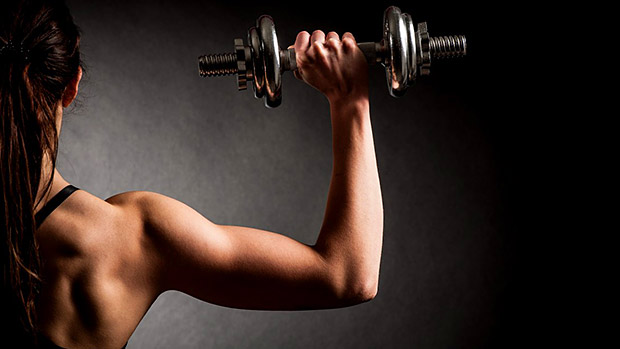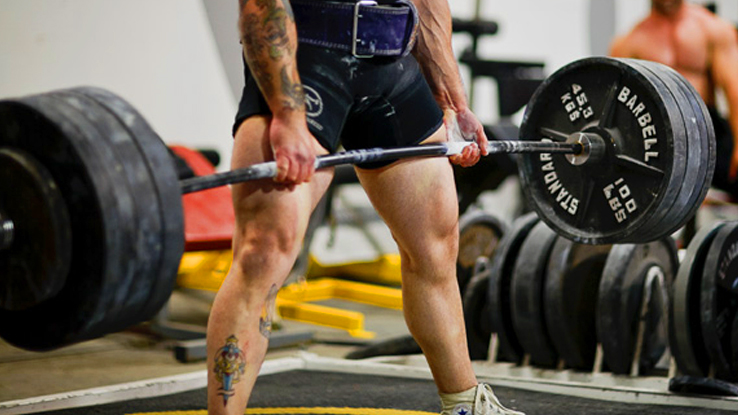Although great strides have been made in the war against female fear of muscle, or myophobia (CrossFit deserves much of the credit), muscle is still often regarded with curious suspicion and sometimes outright distrust in female fitness circles.
Sure, on some level, most women these days understand that muscle can have value, but there's still a significant amount of (unnecessary) trepidation about becoming overly muscular.
On a certain level, women's mistrust of muscle makes sense. After all, one of the most immediately recognizable masculine traits is conspicuous muscularity, a trait most women want to avoid. But muscle is certainly not a universally masculine feature.
Beyond that, the inescapable truth is that women with the most admired physiques also tend to be significantly more muscular than the average woman. So let's clear up the misconceptions and concerns that women often have about building muscle.

- Muscle is very difficult for women to acquire. This is especially true for women who are older and/or dieting.
- Any muscle you do gain is acquired very gradually – there will always be plenty of time to apply the brakes if you feel you're becoming too muscular.
- Most women find that if and when they do build new muscle, they like it much more than they imagined.
- But, if they end up not liking it, no problem! It's very easy to lose.
- Muscle is what gets (and keeps) you lean. It's commonly known that men can eat more than women without consequence, even if you match them for bodyweight. More muscle is the main reason why.
Interestingly, many people tend to think of metabolism as a mysterious external force, kinda like gravity – you can't touch it, you can't see it, but darn it, it sure comes to a screeching halt right after your 40th birthday, doesn't it? (Your metabolism, not gravity.)
Mmm, not really. "Metabolism" simply refers mainly to your energy expenditure. There are four primary categories:
- "Basal" metabolism: This is the amount of energy you need to survive. You need a minimal amount of energy to keep all of your organs functioning and to maintain key survival functions such as consciousness, respiration, temperature maintenance, and so on.
- Non-Exercise Activity Thermogenesis (N.E.A.T.): This is the additional energy you need to perform any and all activity excluding formal exercise. This includes walking, work activities (from relatively sedentary work to manual labor), sitting and rising from chairs, pacing, fidgeting, household chores, literally any activity that isn't "exercise."
- Exercise Activity: The energy you need to perform, and recover from, any type of formal exercise.
- Thermic Effect Of Food (T.E.F): Whenever you eat food, it requires a certain amount of energy to process (digest, absorb, eliminate) that food. It takes between 5 and 15% of the calories in carbs and fats to process them. Protein requires a bit more work to process, requiring between 20 and 35% of its calories.
All that being said, muscle beneficially affects total metabolic rate in three different ways:
- The training required to build additional muscle requires energy, both to perform, and also to recover from.
- Once acquired, this new muscle requires you to expend additional energy on a daily basis simply to maintain the new muscle. Both basal metabolism and NEAT increase.
- When you have more muscle, all activities are easier to perform, making it likely that you'll do more of these activities, which of course, requires additional energy.
So, gaining as much muscle as possible has a powerful impact on metabolic rate. Still, some women might have some psychological barriers to overcome.

The Thanksgiving Dinner Effect
Have you ever felt disgustingly fat after a huge holiday feast? Of course you have, but you haven't gained ANY measurable fat after a single meal, no matter how gluttonous it may have been. But your attention has been diverted to your stomach, because it's stuffed full of food. So you feel fat.
The same phenomenon applies to lifting weights. Both during and after a workout, your muscles will burn from lactic acid accumulation and swell with blood. Both of these phenomenon focus your attention to your working muscles, which are now temporarily bigger due to being pumped.
The Knee Surgery Effect
I never noticed knee scars until I had knee surgery. But, the very day I got out of the hospital, amazingly, everyone suddenly had knee scars.
Well, not really, but it's just that I suddenly started thinking a lot about knees and knee surgery, which caused me to start noticing people's knees and their scars.
Similarly, when women start training, say, their legs, they often start feeling, noticing, and observing their legs, and often with the suspicion that muscle is being gained. And, needless to say, if a woman experiences a pump for the first time ever, she's likely to mistake it for sudden muscle gain.
The Female Strength Athlete Effect
When novice female lifters start looking around the female strength/fitness sphere, they'll no doubt notice a number of heavily-muscled female strength athletes, and quite reasonably conclude that lifting leads to conspicuous muscle growth.
However, these conclusions are often a case of correlation being mistaken for causation. More often than not, women who are naturally strong and muscular gravitate toward activities that reward their natural gifts, much in the same way that many very tall people tend to discover sports like volleyball and basketball.
And let's not forget that many genetically elite women in the physique world are using drugs too. Most women will never "accidentally" get too big unless they also "accidentally" start using muscle-building drugs.

Over the course of my long (30-year) coaching background, I've found three particularly effective arguments to counter female myophobia. These thought experiments, when presented to reluctant female clients, often serve to create a bit of cognitive dissonance that lead to deeper thinking on the subject:
- "So, you think that exercise will actually make you look worse?" I always say this in a semi-joking manner, but it's a powerful gut-check, and a very effective way to reframe the issue.
- While working with women over the age of 35 who are concerned about gaining too much muscle, I'll often ask, "At what age did you have your best body ever?" The answer almost always ranges between late teens to early '20's.
- I then suggest that this was the age when she had the most muscle ever. This again causes a reframing of the whole "more muscle" concept. Now she's not thinking about a bulky heavyweight powerlifter, but rather her own body when she looked her absolute best.
- I'll also share photos and videos of high-level female strength athletes who have conventionally attractive, yet muscular physiques, of which there are many. I'll share these images randomly, rather than during the course of a discussion about getting too muscular.
Whether you're a male or female lifter, I'm sure you know women in your life who'd benefit greatly from a solid resistance-training program but are still on the fence about pulling the trigger. If you find this article persuasive, please share it with them. Help spread the enlightenment!





